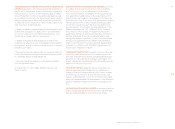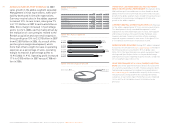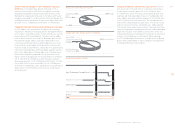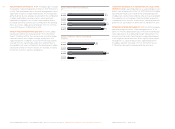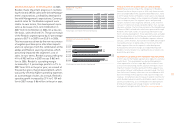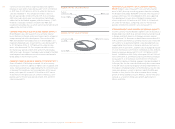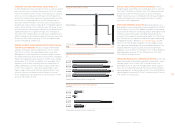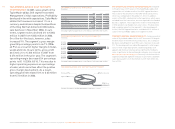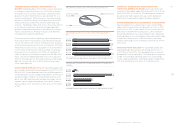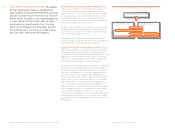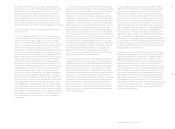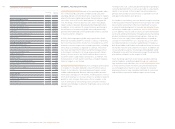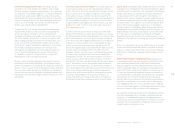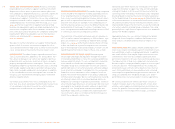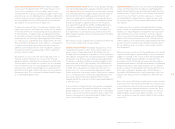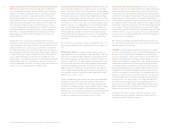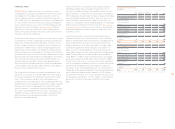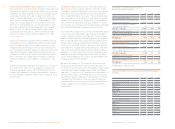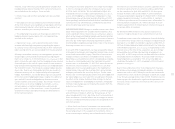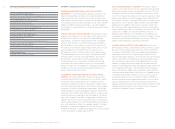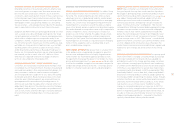Reebok 2007 Annual Report Download - page 109
Download and view the complete annual report
Please find page 109 of the 2007 Reebok annual report below. You can navigate through the pages in the report by either clicking on the pages listed below, or by using the keyword search tool below to find specific information within the annual report.105
ANNUAL REPORT 2007 --- adidas Group
03
Of signifi cant importance is our Group’s Risk Management
Manual, which is available to all Group employees online. The
manual outlines the principles, processes, tools, risk areas
and key responsibilities within our Group. It also defi nes
reporting requirements and communication timelines. Our
Group supplements this top-down, bottom-up approach to
risk and opportunity management by employing our Global
Internal Audit department to independently assess and ap-
praise operational and internal controls throughout the Group.
The main components of our risk and opportunity manage-
ment process are:
- Risk and opportunity identifi cation: The adidas Group con-
tinuously monitors the macroeconomic environment, develop-
ments in the sporting goods industry, as well as internal
processes to identify risks and opportunities as early as pos-
sible. Local and regional business units have primary respon-
sibility for the identifi cation and management of risk and
opportunities. Central risk management has defi ned a catalog
of potential risks and opportunities for our Group to assist in
the identifi cation process. In addition to the potential fi nancial
impacts from changes in the overall macroeconomic, political
and social landscape, each business unit actively monitors
brand, distribution channel and price point developments in
our core sport, leisure lifestyle and sport fusion markets. A
key element of the identifi cation process is primary qualitative
and quantitative research such as trend scouting, consumer
surveys and feedback from our business partners and con-
trolled space network. These efforts are supported by global
market research and competitor analysis. Here, secondary
material such as NPD Sports Tracking Europe or SportsScan-
Info market research data is analyzed and global relationships
with independent trend and media agencies such as QRC,
ICON Added Value and Trendwatching.com are maintained.
Through this process we seek to identify the markets, catego-
ries, consumer target groups and product styles which show
most potential for future growth at a local, regional and global
level. Equally, our analysis focuses on those areas that are at
risk of saturation, increased competition or changing con-
sumer tastes.
- Risk and opportunity assessment: Identifi ed risks and oppor-
tunities are assessed with respect to (1) occurrence probability,
and (2) the potential contribution loss or profi t, with contribu-
tion being defi ned as operating profi t before intra-Group
royalties. The occurrence probability of individual risks and
opportunities is evaluated on a scale of 0 to 100 % likelihood.
In this report, we summarize these fi ndings by utilizing “high”,
“medium” or “low” classifi cations to represent an aggregate
likelihood for various risk and opportunity categories. As risks
and opportunities have different characteristics, we have
defi ned separate methodologies for assessing the potential
fi nancial impact. With respect to risks, the extent of potential
loss is measured on a case-by-case basis as the contribution
deviation from the most recent forecast under the assumption
that the risk fully materializes. This calculation also refl ects
the effects from risk-compensating measures. In assessing
the potential contribution from opportunities, each opportunity
is appraised with respect to viability, commer ciality, potential
risks and the expected profi t contribution. This approach is
applied to both longer-term strategic prospects but also
shorter- term tactical and opportunistic initiatives at both the
Group and, more extensively, the brand level.
- Risk and opportunity treatment: Risks and opportunities are
treated in accordance with the Group’s risk and opportunity
management principles and the Risk Management Manual.
Line management in cooperation with central risk manage-
ment and, in exceptional cases, the Executive Board and / or
Supervisory Board, decides which individual risks we accept
or avoid and those opportunities to pursue or forgo. As part of
this process, we also decide on which risk-compensating or
transfer measures will be implemented. Similarly, to maximize
opportunities, it may be necessary to reduce or limit distribu-
tion to protect prices and margins or prolong product life-
cycles. In some cases, we also seek to transfer the responsi -
bility or execution for certain risks and opportunities to third
parties (e. g. insurance, outsourcing, distribution agreements
or brand sub-licensing).
- Risk and opportunity monitoring and controlling: A primary
objective of our integrated risk and opportunity management
system is to increase the transparency of Group risks and
opportunities. In addition, we also seek to measure the suc-
cess of our risk-compensating initiatives. The Group centrally
monitors each of these efforts on a frequent basis. In particu-
lar, central risk management regularly examines the results
of actions taken by operational management to accept, avoid,
reduce or transfer risks over time. With respect to opportuni-
ties, we regularly monitor the objectives and key performance
indicators established during the initial identifi cation and
evaluation process. This not only facilitates the validation of
opportunities but also allows us to adapt and refi ne our prod-
ucts, communication and distribution strategy to ongoing
developments in our rapidly changing marketplace. In particu-
lar, we collaborate with our manufacturing partners and retail
customers to evaluate the impact of our growth and effi ciency
initiatives. Feedback is relayed in a timely manner to product,
marketing and controlling functions.
- Risk and opportunity aggregation and reporting: Central risk
management aggregates Group-wide risks and reports them
to the Executive Board on a regular basis. Individual risks are
aggregated based on the sum of all assessed risks (sum of
occurrence likelihood × potential net loss), taking correlations
between individual risks into account. Risks with a likely
impact of at least € 1 million on the forecasted full-year contri-
bution are reported to central risk management on a monthly
basis. In addition, risks with a likely fi nancial impact of € 5 mil-
lion or more are required to be reported immediately upon
identifi cation to central risk management. Opportunities are
aggregated separately as part of the strategic business plan-
ning, budgeting and forecasting processes. The realization of
risks and opportunities can have a critical impact on our ability
to achieve our strategic objectives. Therefore, Management is
updated in regular business reviews, but also through ad hoc
discussions as appropriate.


